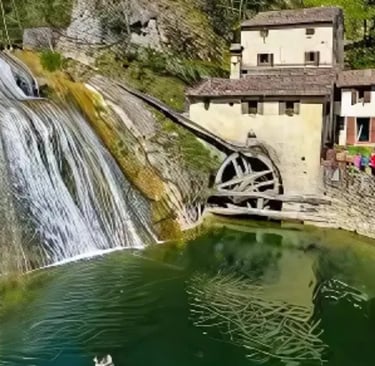The Enchanted Mill: Discover the Hidden Charm of Molinetto della Croda
Step into the magic of Molinetto della Croda, a centuries-old mill nestled in the Veneto hills. Discover its history, natural beauty, and hidden gems that make this Italian treasure a must-see destination.
VENETO


Can you imagine finding a place so picture-perfect that it makes you question whether you've stumbled into a fairy tale? The Molinetto della Croda has that exact effect on visitors. This isn't some manufactured tourist attraction designed to look quaint — it's a genuine piece of living history where the sound of cascading water mingles with centuries of stories carved into weathered stone.
What would compel someone to build a mill right against a dramatic rocky cliff, you might wonder? The answer becomes clear the moment you see how nature and human ingenuity dance together in perfect harmony.
Molinetto della Croda isn't just a place you stumble upon — it feels like a secret whispered to you by the hills of Veneto. Tucked away in Refrontolo, in the province of Treviso, this centuries-old mill leans gracefully against a rocky outcrop and is framed by the gentle rush of a waterfall. The name itself — croda meaning "rock" in dialect — is a nod to the dramatic cliff that guards the mill.
Visiting Molinetto della Croda is like walking into a painting. You hear the sound of cascading water before you even see the mill, and as you turn the corner, the postcard-perfect view reveals itself: stone walls, a wooden wheel still turning, and lush greenery reflecting in the pool below.
A Journey Back in Time
The origins of the mill date back to 1630, when resourceful locals recognized this spot's perfect combination of flowing water and solid stone foundation. For centuries, it served as a working water mill, grinding grain for the surrounding community with methodical precision. Families from nearby hamlets would make regular pilgrimages here with heavy sacks of wheat, maize, or barley, waiting patiently for the slow, rhythmic turning of the ancient millstones. The constant sound of the wheel became part of the valley's very heartbeat.
The mill remained in active operation until the mid-20th century, when rapid modernization made traditional milling economically obsolete. For several decades, Molinetto della Croda stood abandoned, gradually weathered by relentless rain and mountain winds. But passionate local commitment brought it back to life — carefully restored to preserve its authentic character, it now serves as both a protected cultural landmark and a fascinating living museum. Inside, you can examine the original mechanisms, massive wooden beams, and grinding wheels, all telling vivid stories of traditional rural life in Veneto.
Why Visit Molinetto della Croda
Nature Meets History
What makes this site so genuinely enchanting is its remarkable harmony with the natural environment. The waterfall feeds directly into the mill's wheel, creating an atmosphere where human history and landscape blend seamlessly together. On warm summer days, the crystal-clear pool at the base of the falls glimmers brilliantly, reflecting the weathered stone facade like a perfect mirror.
The Perfect Day Trip
If you're staying in bustling Treviso or crowded Venice, Molinetto della Croda makes for the most peaceful possible escape. It's less than an hour from Venice by car, but it feels completely removed from urban crowds and tourist chaos. This represents a perfect example of off beaten path Italy — a spot that's not on every tourist's standard radar but leaves a lasting impression on those fortunate enough to discover it.
A Photographer's Dream
Whether you're capturing the soft morning mist rising mysteriously from the waterfall or the golden glow of sunset bouncing off the mill's ancient walls, every single angle here is absolutely cinematic. Wedding photographers, travel bloggers, and even movie crews have found endless inspiration in this natural stage.
Not Everyone Knows
The charm of Molinetto della Croda extends far beyond its obvious visual beauty:
Hidden passageways: Old pathways behind the mill lead to small caves and interesting rocky formations once used for shelter by shepherds during harsh weather.
A place of legends: Local folklore speaks of protective spirits said to guard the mill, especially during dramatic stormy nights when the waterfall roars much louder than usual.
Wine country connection: Just minutes away, you'll find the renowned vineyards of Prosecco Superiore DOCG — making it incredibly easy to pair a visit with wine tastings in Conegliano and Valdobbiadene, among the beautiful cities of Italy famous for exceptional sparkling wine.
An artistic muse: Painters and poets of the 19th century often set their easels here, inspired by the magical play of natural light on stone and flowing water.
This combination alone makes Molinetto della Croda one of those special hidden gems in Italy that feel like they belong exclusively to you.
Practical Information for Visitors
Opening times: The mill is usually open on weekends and holidays, but check the local municipality site for current updates and seasonal changes.
Entrance fee: A modest ticket helps maintain the site and supports ongoing cultural activities and preservation efforts.
Events: In summer, the mill hosts intimate concerts, art exhibitions, and traditional food festivals, transforming the quiet valley into a lively community gathering place.
Exploring the Surroundings
Molinetto della Croda serves as just the perfect starting point for regional exploration. The surrounding Treviso hills are dotted with authentic rustic trattorias, family wine cellars, and scenic hiking paths. From here you can easily plan a complete route that touches the famous Strada del Prosecco, Italy's oldest official wine road.
Nearby towns worth dedicated visits include Conegliano, with its impressive Renaissance castle, and Follina, home to a beautiful Cistercian abbey with roots stretching back to the 12th century. These quieter corners of Veneto prove definitively that exploring beyond the standard tourist hubs is often the most genuinely rewarding travel experience.
FAQ
Q1: How do I reach Molinetto della Croda from Venice? The easiest way is by car, taking about 1 hour via the A27 motorway. Public transport is limited, but regional buses do connect Treviso to Refrontolo.
Q2: How long should I plan for the visit? About 1–2 hours to properly explore the mill, enjoy the waterfall, and take photos. Add extra time if you plan to visit nearby wineries.
Q3: Is the mill suitable for families with children? Yes — children love watching the water wheel and playing near the shallow stream, though supervision is needed by the water.
Q4: Can you go inside the mill? Yes, the interior is open to visitors on weekends and during events. You'll see the wooden beams, grinding stones, and restored mechanisms.
Q5: Is it worth combining Molinetto della Croda with other sights? Absolutely. Pair it with a visit to the Prosecco hills (UNESCO World Heritage site) for a full day of history, scenery, and wine culture.
